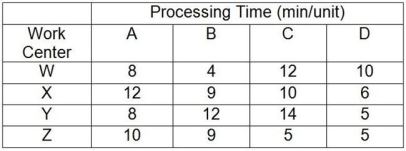Multiple Choice
Table 5.2
A company makes four products that have the following characteristics: Product A sells for $75 but needs $20 of materials and $20 of labor to produce; Product B sells for $90 but needs $45 of materials and $20 of labor to produce; Product C sells for $110 but needs $50 of materials and $30 of labor to produce; Product D sells for $135 but needs $75 of materials and $40 of labor to produce. The processing requirements for each product on each of the four machines are shown in the table.

Work centers W, X, Y, and Z are available for 40 hours per week and have no setup time when switching between products. Market demand is 50 As, 60 Bs, 70 Cs, and 80 Ds per week. In the questions that follow, the traditional method refers to maximizing the contribution margin per unit for each product, and the bottleneck method refers to maximizing the contribution margin per minute at the bottleneck for each product.
-Use the information in Table 5.2. Which work center is the bottleneck operation?
A) Work Center W
B) Work Center X
C) Work Center Y
D) Work Center Z
Correct Answer:

Verified
Correct Answer:
Verified
Q48: Instead of dividing the total standard time
Q49: Use the process flow diagram to determine
Q50: _ is the maximum time allowed for
Q51: The fourth step in Theory of Constraints
Q52: A mixed-model line produces several items belonging
Q54: Table 5.5<br>Balance the following line for an
Q55: Fun Vehicles, Inc. makes beach buggies on
Q56: Variability of a firm's workload may create
Q57: Table 5.3<br>King Supply makes four different types
Q58: Table 5.1<br>A company makes four products that